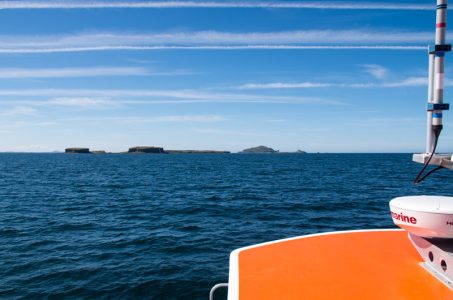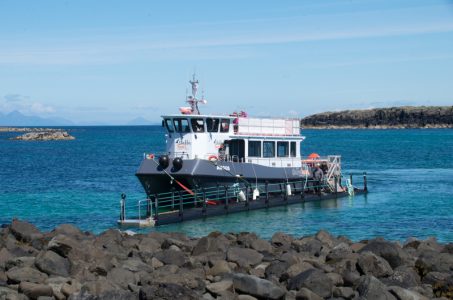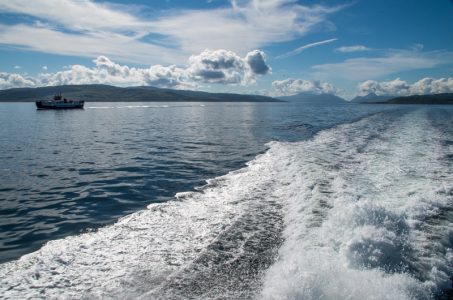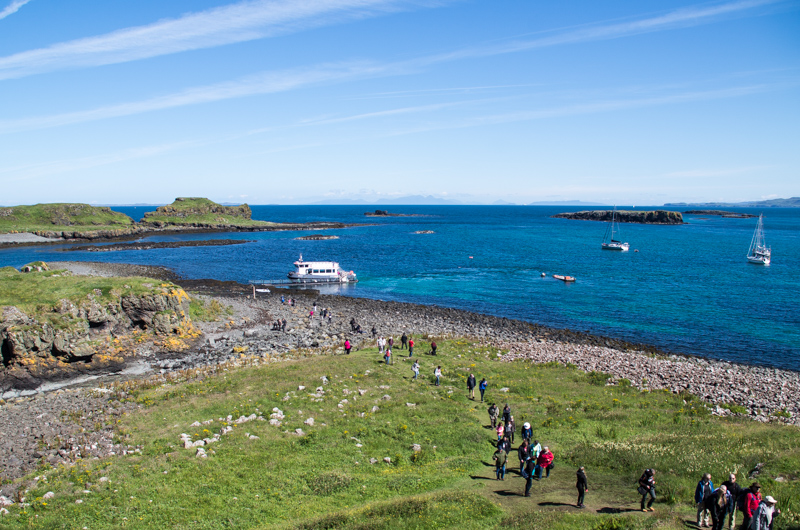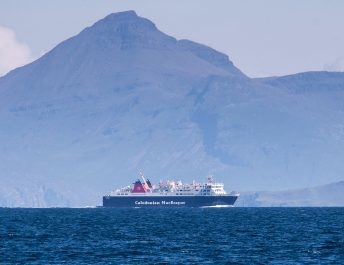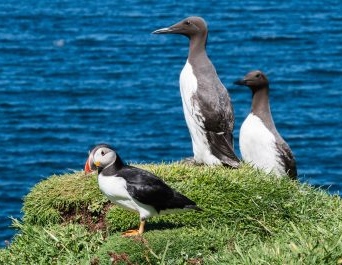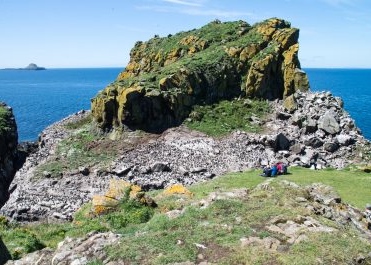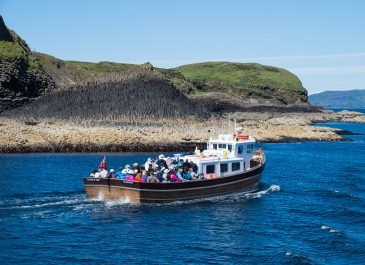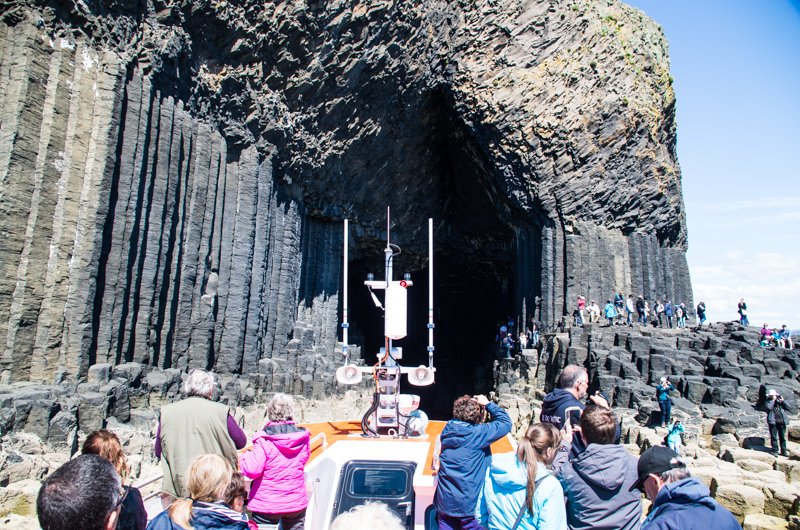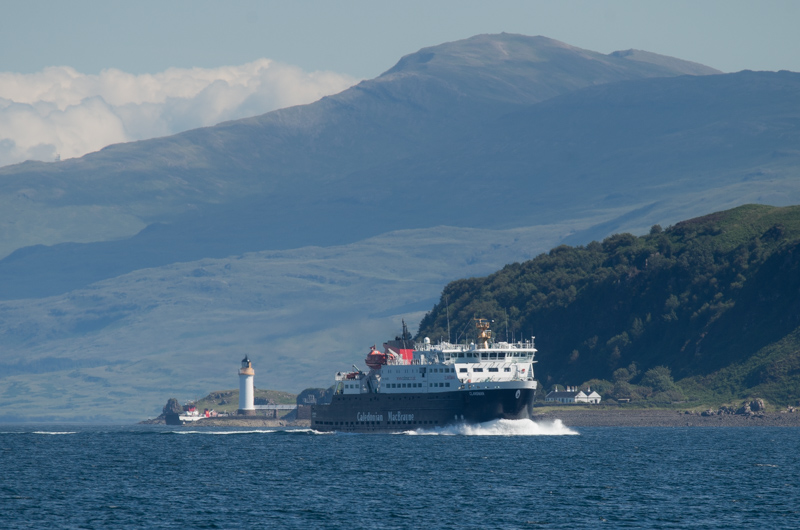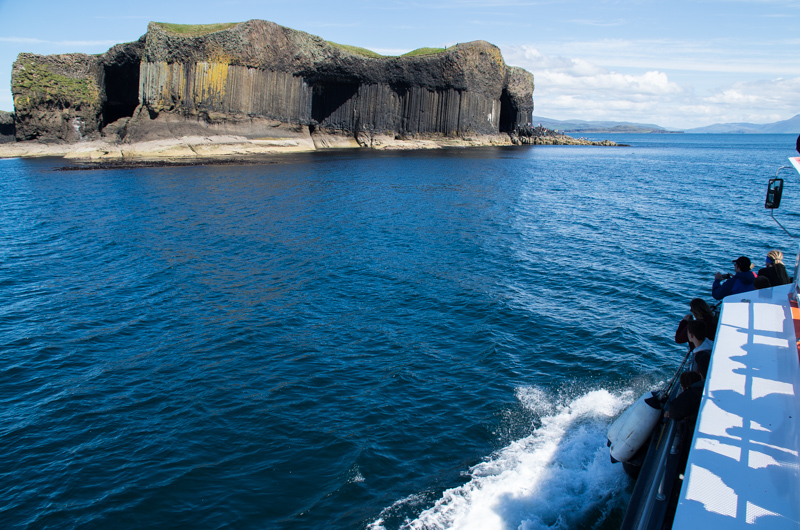
Grandstand view: Angus approaching Staffa, with Fingal’s Cave furthest to the right. Copyright John Newth
Continuing our series on summer cruise options outside the CalMac/Waverley sphere, John Newth explores the smaller islands to the west of Mull.
Having thoroughly enjoyed our sailing from Tobermory to Mallaig aboard Balmoral, Andy Anderson and I spent another night on Mull. The following day we embarked on one of the many small craft that sail from various parts of the island to visit a smaller group of islands lying in the exposed waters off Mull’s western coastline.
Served from Fionnphort, Ulva Ferry and Tobermory, there are three main destinations – Iona, Staffa and the Treshnish Isles – with sailings provided from April until October by three different operators. Iolaire of Iona is owned by the Kirkpatrick family, and runs twice daily from Iona and Fionnphort to Staffa. Turus Mara run two boats from Ulva Ferry – the veteran Island Lass, dating from 1967, and Hoy Lass, a little newer at a mere 42 years old. This firm also runs one of the numerous RIBs that are found all round the west coast and used to give high-speed trips for smaller numbers of passengers.
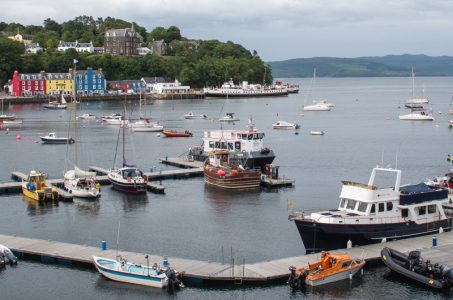
Balmoral at Tobermory pier on July 10, with Loch Tarbert at the slipway behind her and Angus on the pontoon in the centre foreground. Copyright John Newth
The largest operator by far is Gordon Grant of Iona, whose Staffa Tours fleet was augmented last August by the acquisition of Tobermory-based Sealife Surveys. In addition, Staffa Tours has also just taken delivery of a new 16-metre catamaran named Angus, which is capable of carrying 98 passengers, and which we chose to sail aboard from Tobermory.
Having checked that the good weather was due to continue, we booked places the previous day for our excursion, and a good job we did, as there was a near-capacity load for our trip.
Arriving in good time at the pontoons at Tobermory’s Ledaig Car Park, we noted that our craft for the day was over at the MacBrayne pier, where she was taking on fuel from a road tanker. But with around 20 minutes to go before the allotted departure time, Angus was on the way back to the pontoon, threading a twisting course between the numerous yachts anchored in the bay.
We were soon aboard, and chasing Loch Tarbert across the Sound of Mull to Kilchoan. Having easily overtaken her, we reached Mingary Pier where a dozen more passengers joined, and we were on our way again before the CalMac ferry had reached the slip. Today the seas were smooth, there was just a light northerly wind, and standing on the upper deck in glorious sunshine was most pleasant as we sped towards the Treshnish Isles at 16 knots.
With Coll clearly visible to starboard, and the Small Isles and Skye on the quarter as we headed south-west towards Caliach Point on Mull, we could see Isle of Lewis on her inward run from Barra and Clansman making her way back to Oban, ready to embark a second load of passengers heading to the Tiree Music Festival.
Passing the Carnburgs, the most northerly islands of the Treshnish group with their ruined fortifications prominent against the skyline, it was not long before we were picking up the pontoon used to land on Lunga’s boulder-strewn shoreline.
The pontoons at Lunga are kept on moorings – one each for Turus Mara and Staffa Tours – and are picked up by the visiting boats as required. Once they have been run in to the beach, and passengers put ashore, the boats back out again and return the pontoon to the mooring.
These temporary landing stages have stood the test of time, and are the most practical way of getting visitors on to the island.
After clambering over the rocky beach, we were soon on the grassy track and heading towards the path that leads up to the part of the island where many of the estimated 3,000 puffins have their burrows from May until the end of July.
It is a truly magical experience seeing these comical little birds at such close quarters, and they are totally unfazed by the presence of so many humans as they flew ashore and disappeared into their burrows – in fact, before going ashore, we had been told by the very knowledgeable crew that the puffins appeared to appreciate us being there, as our presence kept predators – gulls and skuas – at bay.
We had been advised by the crew to continue past the puffin burrows and to visit Harp Rock on the west side of the island, home to several thousand roosting birds. The cacophony was incredible as we approached – fulmars, kittiwakes, razorbills, guillemots, cormorants and, of course, puffins were everywhere.
From our spot overlooking the rock we could also see the distinctive Bac Mor – known as the Dutchman’s Cap – lying to the south as Andy and I indulged in our lunch, a picnic we had brought with us as there are no facilities to eat on board the boats.
All too soon it was time to return to our boat, which had been lying off Lunga along with fleetmate Ullin of Staffa at the moored pontoon. Once back aboard, we continued south towards Staffa.
As we approached the west side of the island we were greeted by a pod of eight bottlenose dolphins. These mammals will play enthusiastically with any boat, but seemed to really enjoy our boat Angus with its twin hulls. After circling for a short time we had to leave them to entertain the passengers on Turus Mara’s Hoy Lass as we continued towards Fingal’s Cave.
Sea and tidal conditions were good enough to allow Angus to get close to the mouth of the cave, giving us a grandstand view of the legendary hexagonal basalt columns that rise spectacularly out of the water to form the world-famous cavern that inspired Mendelssohn to write his Hebrides Overture after visiting the island in 1829.
Landing was made at the concrete jetty on the south-east side of the island, and Andy and I decided – both having visited Fingal’s Cave previously – to climb to the top of the island. It was well worth it.
About eight miles to the south we could see Balmoral at anchor in the Sound of Iona, with another of Staffa Tours’ boats, the catamaran Islander – which had recently been usurped by our Angus at Tobermory – providing a tender service as Loch Buie crossed to the Sacred Isle from Fionnphort. Even further away we could clearly make out the Paps of Jura as we ate the rest of our picnic lunch.
All too soon it was time to head back down the steps to the landing stage, and re-board Angus for the return sailing.
This time it was decidedly cooler for, although the sun was still splitting the skies, we were sailing into the wind. Again we could see Isle of Lewis making her way west and, as we entered the Sound of Mull, Clansman was passing Tobermory with Loch Tarbert emerging from behind the lighthouse at Rhuba nan Gall.
After landing our Kilchoan passengers, it was a 15-minute sailing back to Tobermory, ending a wonderful day on the west coast’s newest small-trip boat which, although a complete contrast to the one Andy and I had enjoyed the previous day, was every bit as much fun.
These small boats have an appeal of their own, admittedly perhaps not for everybody but, whether for the scenery, the wildlife, or just for the sheer exhilaration of sailing in open waters, it’s well worth joining one of them for a special sailing experience on the west coast.
MORE SUMMER CRUISING OPTIONS OUTSIDE THE CALMAC/WAVERLEY SPHERE:
Three Lochs Tour — with a difference












